Puzzling changes in the Cross and Tressure Designs on Mexican Escudos 1711-1714
by Phil Flemming
Changes in the designs of Mexico’s first gold coinage, the so-called “cob coinage” of 1679-1732, have not excited the curiosity of numismatists or archivists, yet some of these changes, especially in the period 1711-14, were most curious. From the beginning Mexico City copied the basic types of the Spanish Peninsular gold coinage: on the obverse, crowned royal arms flanked by mint mark, assayer and denomination; on the reverse, a tressured Cross Potent with fleurs-de-lis intruding into the angles of the cross. Legends, continuing from obverse to reverse, named the monarch and his titles. For example, PHILIPPVS V DEI G 17XX…HISPANIARVM ET INDIARVM REX. Peninsular legends omitted the ET INDIARVM. In the 53 years of its first gold coinage, Mexico City did not abandon or radically alter any of these basic types, though significant modifications were made at least seven times before 1716 to the cross and tressure. None of these cross and tressure modifications, by the way, were connected to or correlated with the introduction of Philip’s Bourbon arms in 1702. To be sure, the crown and shield on the obverse changed in 1702, but nothing in the design of the cross and tressure changed at this time (or for eight years).
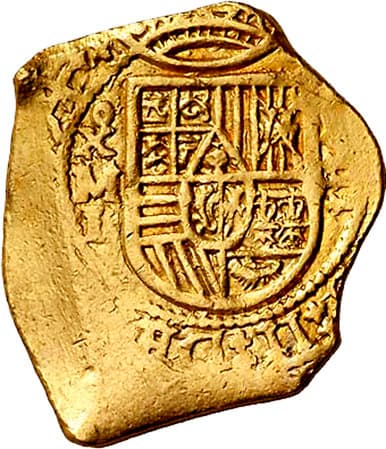
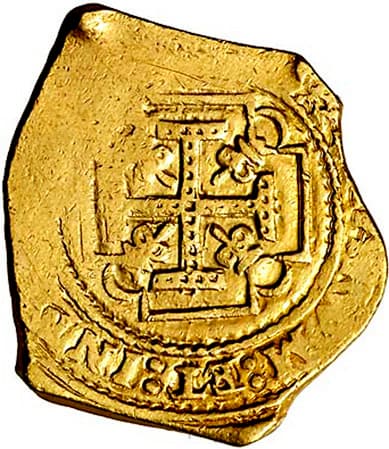
1694 8 Escudos (Tauler 127)
Throughout almost all of the first twenty-one years of the Mexican gold coinage, 1679-1699, Mexico used flat, thick cross punches for its cross and shield designs. On the eight escudos, the main cross member measured 14 mm across with perpendicular 6 mm cross bars. Four large, cactus-like fleurs-de-lis intrude into and nearly fill the angles of the cross, creating a somewhat crowded central design. The thickness of the Cross Potent permitted and apparently invited a hand-stippled decoration on the dies. Rather than the more accurate if pedestrian “holed cross”, modern nomenclature has settled on “Jeweled Cross” for the design. No other Colonial or Peninsular Spanish mint had ever “jeweled” its crosses, which may have been in part a motive for the innovation. Considerable archival material from the fall of 1679 has very recently become available, but absolutely none of it mentions the novel cross design. This suggests that perhaps the “jeweling” of the cross was a design element left to the judgment/preferences of the long-serving Tallador Major, Juan de Cabueñas.
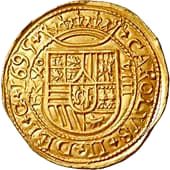

1697 Carlos II 8 escudos (Tauler 129)
In 1695 Mexico City replaced its eight escudos cross punches with much thinner punches that had no room for “jeweling”. Eight escudos crosses were for the next five years “Plain Crosses”, though on one 1696 onza there was a not very successful attempt to “jewel” several crossbars. We illustrate the new Plain Cross design with the unique and beautiful 1695 eight escudos galano. Notice how the thinner cross and smaller fleurs alleviate the crowded central design. On the lesser denominations the cross story is more complicated. The older thick cross punches were still serviceable—they had seen much less use than the onza punches—and were used alongside newer thin punches. Sometimes the tallador decided to use an older rather than newer punch. If he judged that the top of the cross was broad and flat enough to jewel, he did so. Otherwise he did not. The 12 mm cross on the four escudos, for example, is not jeweled on a 1698/7 cross die but jeweled on a 1699/8 die, which appears to use the same punches. A 1698, but not a 1697, two escudos cross die is jeweled. The lesson seems to be that at least in the 1695-99 period “jeweling” was not a prescribed or settled design feature, but an optional adornment that the tallador deployed when he wished. On galanos the tallador seems to have recognized that the Plain Cross was aesthetically a better choice.
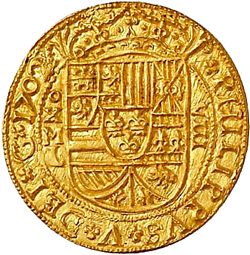
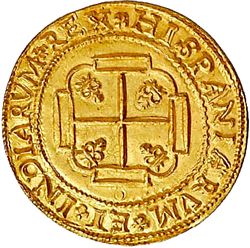
1702 Felipe V 8 escudos (Tauler 377)
In 1699 tallador Juan de Cabueñas dies, and in 1700 the office passes by inheritance to the husband of Juan’s daughterFor the identification of the Mexican talladores, this essay owes a great debt to unpublished research by Jorge Proctor. The biographies of Cabueñas, Carbadillo, and Don Pedro used here are based on documents very recently recovered by him from Mexico’s Archivo General de la Nacion (AGN) and soon to be published. As a companion to his recent study of Mexican Colonial assayers, it is hoped that Jorge will soon offer us a comprehensive study of the Mexican Colonial talladores.. Immediately a conspicuous design change occurs on the cross side. The framing four-sided tressure is discarded, and the four short crossbars are replaced by four rectangular boxes typically about 8 x 2 mm. The boxes are linked by four short lunate tressures. We will illustrate the new design with a 1702 eight escudos galano. Four fleurs continue to float in the angles of the cross, usually positioned close to the tressures. The new cross design of 1700 goes by the modern name of the Box-end Cross. No Spanish Peninsular escudos ever show anything like a Box-end Cross design.
No Mexican mint documents yet found refer to this change. For reasons to be made clear, there may not be any to be found. Nothing suggests that this a mandated or official design change. This change is not linked to the replacement of Carlos’ Hapsburg shield with the new Bourbon shield of Philip V. That occurs with the 1702 coinage in Mexico, based on documents Mexico does not receive until January of that year. Dated 1700 and 1701 Mexico continue to show the Hapsburg shield, but now paired with the Box-end Cross. Mandated design changes not connected to a succession, moreover, typically imply a criticism of the replaced design or the coinage itself. No evidence suggests that the Jeweled and Plain Cross designs were viewed as controversial or that anything was wrong with the gold coinage of Manuel de Leon (assayer L). The only interesting development that occurs at the Mexico City mint in late 1699 is the appointment of Don Diego Manuel de Carballido y Zurita as the new Tallador Mayor of the Casa de Moneda. Don Diego replaces the recently deceased Juan de Cabueñas. In Cabueñas’ tenure, as we saw, Jeweled Cross reverses and more recently Plain Cross reverses had appeared. Now with the arrival of a new Tallador Mayor a new cross design appears. Don Diego’s tenure as owner lasts eleven years, until he sells the office in the fall of 1710. He is replaced in time for the 1711 coinage by the very wealthy Don Pedro Sánchez de Tagle, soon to be created the second Marquis of Altamira. Significantly, Don Diego’s Box-end Cross design is also brought to an abrupt end with his departure and the arrival of Don Pedro.
The new Marquis of Altamira, and his father-in-law and uncle, the first Marquis of Altamira, Don Luis Sánchez de Tagle, were critical players in the development of Mexican mining and banking. A bitter rivalry and feud with the previous virrey, Don Francisco Fernández de la Cueva, the Duke of Albuquerque, had led to trials and a brief exile for the Tagle family. By 1710, because of their wealth and influence at court, the Tagle family had once again reclaimed their Mexican commercial empire. Their enemy, the Duke of Albuquerque, was retired to be replaced by a new virrey, Don Fernando de Alencastre Noroña y Silva, the Duke of Linares, a man much more sympathetic to Altamira’s plans. Don Pedro Sánchez de Tagle celebrated the restoration of Tagle influence by buying, another among other things, for life and in perpetuity the office of Tallador Major of the Mexican mint.
We do not have an obvious reason why the Marquis’ talladores discarded the successful Box-end Cross design of 1700-1710. It is possible the Marquis of Altamira saw some personal/political significance in terminating the coin designs associated with the Duke of Albuquerque’s controversial tenure. The royal Bourbon shield of Philip V could not be capriciously altered, but the cross design was not so protected. The marquis’ actions and motives are conjecture at this point, but what is not conjecture is that the Box-end Crosses disappear abruptly and permanently at the end of 1710. No serviceable escudos cross dies in any denomination carry over into 1711. Again, no mint documents have anything to say about this change, but it is possible the wealthy and powerful Marquis of Altamira felt he did not need to seek anyone’s approval to affect these changes.
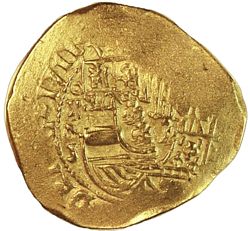
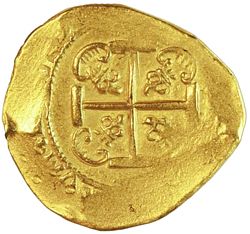
1711 Felipe V 8 escudos (Tauler 385)
What is most striking and unprecedented about the changes we associate with the Marquis of Altamira is that not one but two very different cross redesigns premier together in 1711. Both designs continue into 1712 and one into 1713, after which yet another cross design appears in 1714, supplanting the designs of 1711-13. To the left we illustrate one of the new designs of 1711, now called the Ornate Tressure design. The Ornate Tressure is often assumed to be the first new design introduced in 1711, but the evidence for this, as we will see, is completely lacking.
The Ornate Tressure design features a thin plain Cross Potent ending in the solid style of crossbar favored on the Plain Crosses before 1700. Gone are the boxes. Ornate tressures with recurved ends and fronds are sandwiched between and sometimes connect its crossbars. These tressures are in a style not seen on any other Mexican or Spanish coinage. Potosí’s reales do use high arcing tressures, usually bracket-shaped when well executed, enclosing the ends of its Jerusalem crosses, but it is clear that Mexico’s Ornate Tressures owe nothing to Potosí. One element of the design does connect with the previous Box-end crosses: the fleurs-de-lis in the angles of the cross show much the same style as 1700-1710 fleurs.
If the extant coinage is a reliable guide, most of the business strike onzas produced in 1711 used the Ornate Tressure reverse, while all (9) of the 1711 galanos use the Cross Fleury design. Ornate Tressure one, two and four escudos are all very rare, with the Cross Fleury design dominating those denominations. Prior to the salvages of the 1715 Fleet beginning in the early 1960s, the Ornate Tressure design was apparently unknown to scholars of the Mexican cob coinage. MedinaJosé Toribio Medina, Las Monedas Coloniales Hispano-Americanas, Santiago, Chile, 1919, for example, does not know about Ornate Tressures, nor does PradeauAlberto Francisco Pradeau, Numismatic History of Mexico from the Pre Columbian Epoch to 1823, Los Angeles, 1938. López-Chaves in his 1961-64 monographs on these seriesLeopoldo López-Chaves y Sánchez & José D. Yriate y Oliva, Catálogo de la Media Onza ó Doblon de a Cuatro, Madrid, 1962: Catálogo del la Onzas de América Independiente, Madrid, 1962: Catálogo del Doblon de a Dos Escudos, Madrid, 1964 also makes no mention of this design. But for the 1715 Fleet, it seems, this ephemeral coinage design might have disappeared into history.
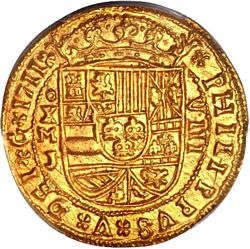
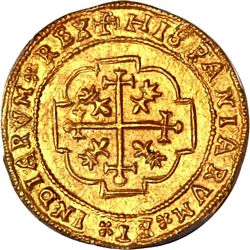
1711 Felipe V 8 escudos (Tauler 384)
Pictured to the left is the reverse of a 1711 galano. Clearly it does not show an Ornate Tressure reverse. Instead, it shows the other new design for 1711, now called the Cross Fleury or Cross with Crosslets. Thin crossbars with flaring crosslets in the style of a Cross Patee are surrounded by (a)symmetric brackets and thin tressures arcing between them. The fleurs in the angles of the cross show a novel, doll-like style. Cross, tressure, and fleurs look nothing like the Box-end Crosses of 1700-1710 nor the previous Jeweled Crosses. A completely novel design, and one the Mexican talladores were clearly having a very difficult time executing. Only one of the four final crosslets (top) is competently executed. And this is a galano die! Look also at how irregular and asymmetric the brackets and tressures are. Here the mystery of the Cross Fleury design deepens. Cross Fleury dies remain poorly engraved in 1712 and 1713. Why was a design the Mexican talladores struggled with and never mastered chosen to replace well-made Box-end Crosses? In 1712 Cross Fleury reverses again carry most of the one and two escudos coinage, while Ornate Tressures dominate in the four and eight escudos denominations. At the end of 1712 the Ornate Tressure reverses are retired, while Cross Fleury reverses becomes the only design used in 1713.
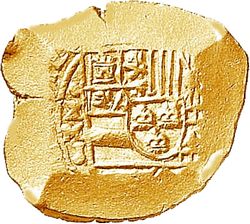
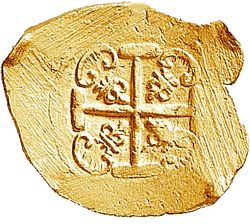
1712 Felipe V 8 escudos (Tauler 386)
Some numismatists have suggested that the Cross Fleury design was introduced later in 1711, specifically as a replacement for the “unsatisfactory” Ornate Tressure design, which it completely supplants by 1713. The point of this speculation seems to be to avoid accepting the very puzzling concurrent use of Ornate Tressure and Cross Fleury designs. The replacement theory has several problems. First we might ask what obvious problem(s) with the Ornate Cross design are supposed to be remedied by the even more problematic Cross Fleury. Surprisingly, no contemporary documents record any dissatisfaction with either new design. A more conclusive objection to the replacement theory is the fact that we have a dated 1712 regular issue onza with an Ornate Tressure (its shield side pictured to the left). This is in fact only the second dated 1712 onza that is known. If the Ornate Tressure design is condemned and discontinued in 1711, how does it manage to return in the 1712 coinage? About a half dozen clearly dated 1712 media onzas second the use of Ornate Tressures with the 1712 business mintages. Rather than being replaced with Cross Fleury dies in late 1711 and throughout 1712, it seems likely that a very large part of the 1712 business strike onzas and media onzas bore Ornate Tressures.
We do not know why Ornate Tressures were discontinued at the end of 1712. Of the two designs introduced in 1711, it seems that the Ornate Tressure was the design the Mexican talladores were best able to execute. No 1712 Ornate Tressure dies were used with any extant 1713 coinage. It seems to have been a deliberate decision as no Ornate Tressure dies were called back into service in the course of the very busy mintage of 1713 (which even repeatedly drafted galano dies into the regular coinage). One suggestion is that no Ornate Tressure dies were left over from the mintages of 1711-12, and no new ones could be prepared. Comparing the Ornate and Cross Fleury designs, one is struck by how different their artistic visions are. The organic, gracefully curving, scallop-like tressures of the Ornate Tressure design share nothing with the sharp, right-angled brackets and (mis-shapen) crosslets of the Cross Fleury. The fleurs in the angles of their cross are also as different as these designs as could be. It is very hard to believe the same working tallador prepared both the Ornate Tressure and the Cross Fleury designs. If the creator of the Ornate Crosses was a tallador working at the mint in 1711, but no longer there by 1713, the decision to continue Ornate Cross designs was not an option.
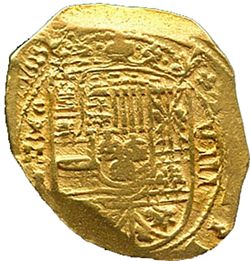
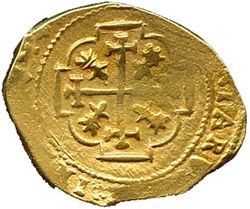
1713 Felipe V 8 escudos (Tauler 390)
1713 is thought by many to represent the absolute nadir of gold die production at Mexico City: shields and crosses are embarrassingly crude and irregular to the point that one can doubt whether an experienced tallador supervised the production. 1713 shields are indeed exceptionally poor, but it is not clear the Cross Fleury dies are noticeably worse than 1711-12. We illustrate a typical example of the 1713 onza coinage. The Cross Fleury design of 1711-12 is unchanged in 1713 except that the crosslets now seem slightly larger and slightly better executed, but clearly engraving problems remain. Our die study of the 1713 onza coinage found four shield and at least five cross dies used in striking our sample of 96 Fleet coins, suggesting a somewhat larger mintage than in 1711 or 1712. In any case, the Cross Fleury dies are permanently retired at the end of 1713 and yet another new cross design introduced.

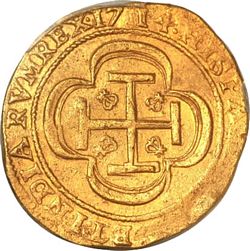
1717 Felipe V 8 escudos (Tauler 396a)
We do not yet know the names of any of the men who the Marquis of Altamira had appointed as his working talladores 1711-13, but the Marquis replaced him/them at the beginning of 1714 with a man who was to prove a competent tallador, Ensign Hipólito de Sarmiento. Hipólito was responsible for executing the experimental but competent first escudo design of 1714. The first cross design of 1714 attempted to place the date on the reverse. This was an experiment, imitating the Spanish mints, and not an error. The purpose in relocating the date to the reverse was to allow better centering of the obverse. The smaller Mexican planchets had been able to achieve a clear legend date only by off-centering significantly to the right and obliterating the king’s name. The innovation failed because the hand-struck escudos of Mexico could not generate the pressures of the milled Spanish coinage. Reverse legends stuck up nicely on Spanish coins, but failed to do so at a very high rate on the Mexican escudos. Instead of yielding better-centered gold issues with clear dates, it soon became apparent that much of the new design came out unacceptably undated.
But fascination with the date is distracting us from the bigger issue: notice we have a completely redesigned cross and tressure. The cross reverts to a thin, plain, highly workable Cross Potent. Four large lunate, double lobed tressures circle the cross at some distance. Smaller, simplified “jelly-fish” fleurs float in the angles of the cross. Not a design copied from or imitating any Spanish Peninsular issue.
It is not possible at this point to offer any authoritative pronouncements on the design changes in the Mexican gold coinage 1711-1714. We have found no good reason why the Mexican mint abandoned the perfectly serviceably Box-end Cross design (1700-10) in favor of two novel designs, at least one which (Cross Fleury) the Mexican talladores struggled without much success to execute competently. We have found no cogent reason why Mexico simultaneously used two cross designs for its 1711-12 gold coinage. This last is particularly puzzling, yet unmistakably so on the evidence of the coins. It is not at all puzzling that Mexico abandoned the Cross Fleury at the end of 1713 and opted for a much more workable and attractive design. Given the precedence of reverse designs changing with new talladores, we have suggested that these are not officially mandated changes, and the prime mover of the changes may have been the powerful Marquis of Altamira, who took over the office of Tallador Major in 1711.
